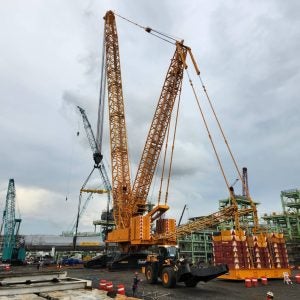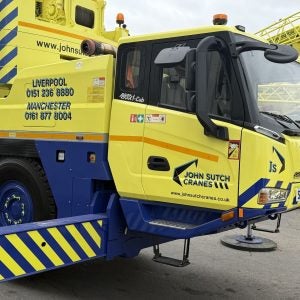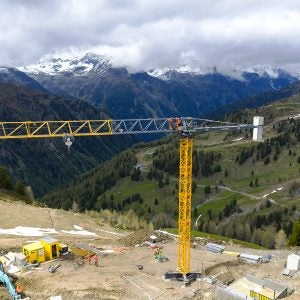Coal-fired power station boiler houses are massive steel structures, especially in brown coal plants, and they need spectacular cranes for their construction. Over the years power generating capacity has risen from 600MW in the 1970s to 950MW today, and the boiler frame structures have got taller, from around 120m to 170m. The immense amount of steel to be erected in ever shortening construction programmes has pushed the crane industry to develop heavy lifters which have sometimes gone on to enter the general construction sector.
A lot of boiler house construction has always been carried out by the biggest rigs available at the time. However, in some cases climbing tower cranes have been the main workhorses. For example, the German power station Weisweiler was built in 1973 using a special pylon-mounted self-climbing DWD 1800 Schmidt Tychsen luffing jib crane, providing a maximum capacity of 100t at a height of 130m. In other cases, specially modified yard cranes were installed by big mobile cranes onto the boiler roof, and used to install smaller parts after the boiler framework was finished. A well proven example was the Liebherr 350L, used from 1971 until the late 1990s. Winch capacity restricted building height to 136m. The maximum capacity of this rail mounted luffer was 24t.
By the time that fast rigging modular saddle jib cranes in the 500tm to 600tm class became available, a new crane concept for taller boiler houses was created. To disassemble the roof-mounted saddle jib crane, a second one was generally tied in at the stairway tower as an umbrella crane. Large British-built Arrol luffers dominated boiler house construction sites in the 1960s. Although most of the 40t and 60t versions were used as bottom climbing, top slewing cranes, some were used on top of boiler houses under construction as non climbing luffers.
While the 1966 veterans provide a lifting capacity of 20t at 33m, the Wolff 60140 B, introduced for the Black Pump power station project in Germany in 1994, could lift the same load to a radius of 50m. The massive Wolff luffing jib cranes, the biggest luffers in Europe today, served the site in two ways: as 90m-high free standing tower cranes, and as boiler roof mounted cranes. Visually, their upper design features can be traced back to Wolff’s slewing shipyard cranes.
Optimising the crane concept at Niederaussem
Supported by experience on the Black Pump power station, the contractors responsible for the K block at Niederaussem power station, near Köln, chose Wolff cranes.
Construction of this power station began in 1998 and its completion is scheduled for 2002.
Under the original design, the boiler house was to be served by a roof-mounted Wolff 160 B crane, with all heavy lifts being carried out by Van Seumeren’s giant Platform Twin Ring, a 2,000t capacity ring-mounted lattice boom crane. One Wolff 60140 B tower crane was to have served the congested side of the boiler house next to the old plant, while the other sides were to be covered by Demag CC 2600 crawler cranes with luffing jibs.
The design envisaged two Wolff 320 BE-G7 units installed on rail tracks running on lower parts of the power plant under construction at heights of between about 43m and 45m. After construction of the boiler house frame, the upper surrounding elements of the suspended boiler would be rigged at ground level up to the lifting height of the crawler cranes. This preassembled structure would then be lifted about 60m, like a giant collar, by strand jacks fixed to the roof frame. So from all sides cranes would have had to move under the hanging part to install the remaining elements of the suspended boiler.
In the case of the side served by the 60140 B, it was planned to install one of the two 320 B-G7s on the associated building at a height of 43m, to fill in the gap caused by the raised first section of the suspended boiler.
However, intensive CAD studies carried out by crane rental company Wilbert Kranservice, which supplied the tower cranes under a DM1.5bn contract, led to a cost-saving alternative solution. Wilbert is a tower crane specialist and established Wolff dealer. Prestige projects in Germany include the Black Pump power station and the 298m high Commerzbank tower in Frankfurt. The 60140 B now working at the Niederaussem power station project was formerly working in central London on a new office block for Members of Parliament.
Wilbert’s solution for Niederaussem was, instead of installing the 320 B-G7, to fit a climbing frame onto the 60140 B already at that side of the building, so that it could raise or lower the tower by adding or removing (depending on the construction situation) two 5m tower segments. When working in front of the crane under the suspended boiler elements, the luffer has to climb down because the raised jib has to slew under the hanging structure. Working under the structure’s corners means climbing the crane in order to extend the lifting radius.
On top of the building, two new Wolff models dominate the construction site. The rail mounted Wolff 180 B, with 50m luffing jib and a maximum capacity of 12t, replaces the originally planned WK 160 B. With the minimum 180m lifting height, the two-fall operation is a real benefit over the WK 160 B’s four-fall requirement for the same capacity.
The frequency controlled crane is responsible for all small loads like repositioning the strand jacks and scaffolding, and fitting steel work. Again the experience of the Black Pump project was valuable when Wilbert engineers consulted the main contractor. They were advised to install a second hook serving the boiler house roof because relying on one hook at such heights could endanger the tight construction timetable.
Long holding phases when fitting steel elements, and the lifting height, as well as bad weather conditions, all have to be considered. A corner column of the boiler house frame was chosen as installation point. Unfortunately crane erection had to be delayed until all corner sections of the boiler house frame had been closed to cope with the corner forces generated by the tower crane with a maximum load moment of 5,040kNm.
On a special frame still available from the Black Pump project, the all new Wolff 320 BF is rigged on two TV20 tower sections. This crane replaces the well known Wolff 320 B. Instead of the extraordinary hydraulic drive, the new generation is equipped with the well proven, service friendly, frequency regulated drive. At the time of development, in the middle of the 1980s, the hydraulic drive provided the highest degree of stepless control, most suitable for steel erection work.
Now the same smooth control is obtained by common frequency controlled drives. While the original 10.3m counterjib version found wide application in the construction of high buildings, it was the space restrictions at the Black Pump power station project that led to development of the 7.2m short counterjib version. The 320 BF can be rigged with a jib 10m longer than its predecessors to cover a maximum radius of 60m.
At the Niederaussem project the crane is equipped with a 40m jib, providing a maximum capacity of 28t in two-fall configuration. Thanks to the new 110kW hoist unit maximum lifting speed is increased by 13%.
New solutions for rigging/derigging above 180m
The first step at Niederaussem was mounting the Wolff 320 BF with the help of the massive Van Seumeren Twin Ring crane in a two day operation in May. About two weeks later the Wolff 180 B was set up the same way. Thanks to the Twin Ring’s massive lifting capacity the partly ballasted undercarriage, slewing frame and tower top were lifted as a single preassembled unit.
Dismantling the roof-mounted cranes will be a tougher challenge, as by then the Twin Ring will have already left the site. Together with the client, Wilbert Kranservice again found a spectacular cost saving solution, supported by CAD. First, the rail mounted 180 B will dismantle the 320 B by driving into the required capacity radius. When it has finished its job, the 180 B will install an innovative Wolff 30 A recovery crane, introduced into the German market by Wilbert. This crane will dismantle the 180 B into components of up to 7t. Because of the limited capacity rate of the 30 A recovery crane, the rails have to be extended beforehand on a specially built support girder hanging over the edge of the boiler house roof. In a specially approved load case the 30 A – with a maximum capacity of 6t – will lower the 7t section.
At present the 30 A is undergoing intensive tests at Wolff’s test yard in Heilbronn. Wilbert also intends to rig the crane at its yard in Stromberg to ensure the viability of the proposed lifting procedure in all details before delivering the crane to the construction site.
The 30 A will be equipped with a revolutionary self-dismantling device. Components will be lowered through the roof girders from 167m high to a level of 157m by using several alternative lifting devices. From there, the building’s lift takes the crane sections down to the ground.
The first application of a recovery crane in Germany will be more economical than the traditional way of bringing down the roof-mounted crane using a large umbrella climbing tower crane. This would have had to remain installed next to the boiler house until the whole construction job was completed.
The 30 A opens up new markets for tower cranes where site conditions are tricky. In Germany a new market niche appears to be under development, supported by the field-experienced engineering technicians of Wilbert Kranservice.






